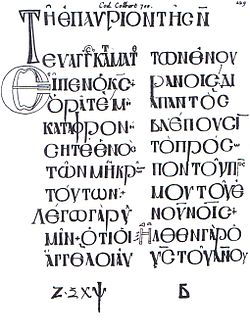Lectionary 1
| New Testament manuscript | |
 Matthew 18:10 | |
| Text | Evangelistarion |
|---|---|
| Date | 10th century |
| Script | Greek |
| Now at | Bibliothèque nationale de France |
| Size | 30 cm by 24 cm |
Lectionary 1, designated siglum ℓ 1 (in the Gregory-Aland numbering), is a Greek manuscript of the New Testament on vellum. Palaeographically it has been assigned to the 10th century.[1] Formerly it was known as Codex Colbertinus 700, then Codex Regius 278.
Description
[edit]The codex contains lessons from the Gospels lectionary (Evangelistarium) with some lacunae.[2] The text is written in Greek uncial letters, on 265 parchment leaves (30 cm by 24 cm), 2 columns per page, 10 lines per page,[1] 7–9 letters per line.[2]
Lessons from the codex were read from Pascha to Pentecost.[1]
History
[edit]Formerly it was variously dated. Scrivener dated to the 8th century,[3] Henri Omont to the 14th century, Gregory to the 10th century. In the present day it is unanimously dated to the 10th century.[4]
The manuscript once belonged to Colbert.[3] It was examined and described by Bernard de Montfaucon,[5] Wettstein,[6] Scholz,[2] Paulin Martin,[7] and Henri Omont.[8] C. R. Gregory saw the manuscript in 1885.[2]
It was added to the list of the New Testament manuscripts by Wettstein.[9]
The manuscript is sporadically cited in the critical editions of the Greek New Testament of UBS (UBS3).[10] It is not cited in UBS4.[11]
The codex now is located in the Bibliothèque nationale de France (Gr. 278).[1][4]
See also
[edit]Notes and references
[edit]- ^ a b c d K. Aland; M. Welte; B. Köster; K. Junack (1994). Kurzgefasste Liste der griechischen Handschriften des Neues Testaments. Berlin, New York: Walter de Gruyter. p. 219.
- ^ a b c d Gregory, Caspar René (1900). Textkritik des Neuen Testaments. Vol. 1. Leipzig: J.C. Hinrichs’sche Buchhandlung. p. 387.
- ^ a b F. H. A. Scrivener, "A Plain Introduction to the Criticism of the New Testament" (George Bell & Sons: London 1861), p. 212.
- ^ a b "Liste Handschriften". Münster: Institute for New Testament Textual Research. Retrieved 31 December 2012.
- ^ B. Montfaucon, Palaeographia graeca (Paris: 1708), pp. 228-230
- ^ Wettstein, J. J. (1751). Novum Testamentum Graecum editionis receptae cum lectionibus variantibus codicum manuscripts. Amsterdam: Ex Officina Dommeriana. p. 62.
- ^ Jean-Pierre-Paul Martin, Description technique des manuscrits grecs relatifs au Nouveau Testament, conservés dans les bibliothès de Paris (Paris 1883), p. 137-138
- ^ Henri Omont, Fac-similés des plus anciens mss. grecs de la Bibliothèque Nationale du IVe au XIVe siècle (Paris, 1892), 21.
- ^ Aland, Kurt; Aland, Barbara (1995). The Text of the New Testament: An Introduction to the Critical Editions and to the Theory and Practice of Modern Textual Criticism. Erroll F. Rhodes (trans.). Grand Rapids: William B. Eerdmans Publishing Company. p. 72. ISBN 978-0-8028-4098-1.
- ^ The Greek New Testament, ed. K. Aland, A. Black, C. M. Martini, B. M. Metzger, and A. Wikgren, in cooperation with INTF, United Bible Societies, 3rd edition, (Stuttgart 1983), p. XXIX.
- ^ The Greek New Testament, ed. B. Aland, K. Aland, J. Karavidopoulos, C. M. Martini, and B. M. Metzger, in cooperation with INTF, United Bible Societies, 4th revised edition, (United Bible Societies, Stuttgart 2001), p. 21, ISBN 978-3-438-05110-3.
Bibliography
[edit]- Henri Omont, Fac-similés des plus anciens mss. grecs de la Bibliothèque Nationale du IVe and XIVe siècle (Paris, 1892), 21.


 French
French Deutsch
Deutsch